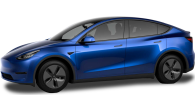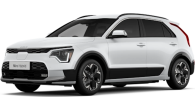Luxury SUVs come in all shapes and sizes these days, but this is the segment where the big boys play. Like, literally. We’re talking about large SUVs. And yes, there is a segment above this one, and a few below it, too.
But this part of the market is regarded as the yardstick for combining plushness and ruggedness, not to mention a touch of tech and more than a pinch of practicality.
These three premium offerings are all German, and while two of them are what you might expect to find when you’re shopping for a high-end large SUV, one of these is from a mainstream brand.

That model is the all-new Volkswagen Touareg, which is easily the oddbod in this segment given that it’s not sold by a luxury marque. We’ve got the Touareg Launch Edition version, which has five seats - there is no seven-seat option - but it’s more affordable than pretty much everything else in the class, though it arguably lacks the badge cred some customers may be looking for if they’re spending this much.
That’s not the case for the all-new Mercedes-Benz GLE, though - while it may have been known as the ML in years gone by, the GLE has been a worthy contender in the class for about five years, and this all-new version features improved interior design and tech - and it looks the part, too. We’ve got the entry-level 300d diesel model, which is sold as a five-seater, but ours is a seven-seater.
And then there’s the stalwart, go-to luxury SUV for many customers - the BMW X5. It’s also a new-generation version, having launched in 2018 - but this is our first chance to see how it stacks up against the competition. Ours is the xDrive30d variant, which is the entry level version at the time we’re testing it - but that means it comes in at a higher price compared to its rivals. It’s a five seater as tested, but you can get it as a seven seater, too.
Read on to see how they stack up against one another.
Design
You will no doubt make your own mind up about the styling of these three, but to our collective eye, the classic design of the BMW X5 - which has been refined and reworked over its four generations - is sportier and more luxurious looking, though not without its ‘ummmm’ elements. The lower sections of the front bumper, for instance, are a bit of a mess, and the ever-growing grille mightn’t be to all tastes.
But the X5’s big glasshouse and sculpted metal work - accentuated with the M Sport pack fitted to our tester - combine to give it a substantial but not intimidating look.
The interior, though, is a bit too familiar. We’ve seen these finishes and treatments before, for the most part - so if you’ve sat in a BMW or owned one over the past 15 years or so, things will not be too startling. We’ll explore more below.
_1.jpg)
The VW Touareg might be too understated for some people’s tastes, especially those who are considering it as an alternative to other luxury SUVs that might prioritise style over substance. It’s very Volkswagen in that regard - it isn’t a beauty pageant contender, but it has the angular jawline and solid, muscled body that won’t polarise opinion too much.
It looks smaller than its rivals (and it is) but it’s pieced together really impressively from a design perspective. The way the grille ties the headlights together, and the line that runs from the tops of the lights to the glass and all the way back — it just all works.
The interior of the VW is pretty impressive - you can tell it has a little bit less space to make do with, but you it also has elements that upset the apple cart in terms of design and technology.

The GLE looks vastly different to its predecessor (which was essentially a facelifted version of the ML that came before it), with a more aggressive appearance that is exaggerated by the AMG Sport package fitted to this test vehicle.
But our team was largely at odds with the styling - it doesn’t seem as cohesive as its rivals, with more awkward angles and edges that don’t really work as well as they could. The squared-off arches don’t gel that well with the somehow-really-round-looking multi-spoke 21s fitted to this car. There were some who found the front end really appealing (while others though there was a bit too much black plastic), and some who found the straight-on rear angle to be the GLE’s best (while others found the triangulated tail-lights to be incongruous with the rest of the design).
_0.jpg)
Thankfully, the interior of the GLE was a more agreeable place for all involved, with a design that makes it stand out from the pack. It’s a beautiful space, with amazing quality finishes - the wood trim in our test car was beautiful, reminiscent of the deck of a yacht. There may be too many vents for some people’s tastes, but it’s a more convincing interior than the exterior suggests it might be.
| VW Touareg Launch Edition | 7 |
| Mercedes-Benz GLE 300d | 7 |
| BMW X5 xDrive30d | 8 |
Practicality
If you’re buying a luxury SUV you expect nice finishes and quality materials - but what about when it comes to fitting a family in? You need the space to be pleasant but also practical.
We know that exterior dimensions mightn’t be that important to you - they’re all large SUVs, after all - but here’s a breakdown to help you see how they stack up, if it wasn’t obvious from the images. All of them have big boot areas, which we’ve listed here, and that’s great if you’ve got young kids or teens.
Volkswagen Touareg Launch Edition | Mercedes-Benz GLE 300d | BMW X5 xDrive30d | |
Length | 4878mm | 4930mm | 4922mm |
Wheelbase | 2899mm | 2995mm | 2975mm |
Width | 1984mm | 1950mm | 2004mm |
Height | 1686mm | 1765mm | 1745mm |
Boot capacity (litres) | 810L (VDA) | 825L (VDA) | 650L (VDA) |
You can see that the Benz is longest and has the largest wheelbase, and that was the feeling from the back seat, too.
But check out those boot figures! To give you an idea of how they compare in the real world, we loaded up the CarsGuide luggage in each of these models, and also our trusty pram.
Watch the video or check the interior pictures and you’ll see that the Benz might have a bigger claimed capacity but its higher load-in lip and narrow space makes the cargo zone a little less impressive than the numbers suggest. The VW’s expansive boot opening and wide load space make for easier loading and plenty of space. The BMW’s boot is narrow and deep, and there’s a smaller load space, that’s for sure - but we loved the split tailgate.
Now, if you need seven seats you’re out of luck with the Touareg. No such model exists. But you can get the BMW and Mercedes with a third row - the BMW X5 seven seater layout adds $3700 to the price (note - you also need to option air suspension to get it, adding thousands more), while the GLE 7 seat layout is $3900. The GLE’s third-row package includes a second-row setup with electric seat adjustment, which really adds to the luxe factor.
The second-row space in the GLE is very good, but it’s more than just legroom that makes a good space - there’s also a more comfortable, sculpted seat with better support. The electric seat adjustment adds a bit pinch of luxe to the back row, too, but the folding function is frustrating if you’re going to use the third row a lot. Let’s ignore that, because we’re aiming for a like-for-like five-seat test.
_0.jpg)
The BMW’s back seat offers up a flatter seat, which is uncomfortable, but it is flat, which means it feels wider if you need to fit three across. One thing that’s lovely about the back seat is that there’s a really airy feeling to it, with a lot more glass and more headroom, too.
.jpg)
The X5 and Touareg are about identical for legroom, while the VW has a bit less foot room due to its larger transmission tunnel. It also has a little less headroom due to the sides of the roof lining impinging more than its rivals.
When it comes to storage in the cabin, the VW’s centre console is the smallest here, but all three have generous cup holders and loose item storage between the front seats. Each has door pockets with bottle holsters but the BMW’s door pockets are easily the most capacious, and the BMW is the only one with ‘real’ map pockets instead of mesh ones.
_0.jpg)
What about the design of the cabin?
Our testers all felt the Mercedes - with its dual screens, millions of vents, lush finishes and ‘oh my gosh’ factor - was the most outrightly lush of these three. It’s such a huge step up compared to the previous model, it’s not even funny.
Inside the X5 was a lovely place to be, too, with prominent dual digital displays and surprisingly nice brown leather. It’s great to see a cabin with a different colour seat and door trim to black.
The VW has some hard plastics here and there, but the general look and feel of the cabin is a high quality experience, if not a full-on luxury moment. You’re not going to confuse it with a Golf or Polo, that’s for sure.
Below you’ll see a breakdown of the media system setups for each of these cars, and there’s a bit splitting them - but one thing’s for sure, there’s some wow factor here.
Volkswagen Touareg Launch Edition | Mercedes-Benz GLE 300d | BMW X5 xDrive30d | |
Sound system (standard equipment) | 8 speakers | 8 speakers standard, 13-speaker system fitted | 10 speakers |
USB count | 2 front, 2 rear | 3 front, 2 rear (plus 2 in the third row - optional) | 2 front, 2 rear |
DAB radio | Yes | Yes | Yes |
Media screen size | 15.0-inch optional, 9.2-inch standard | 12.3-inch | 12.3-inch |
Apple CarPlay | Yes | Yes | One-year subscription |
Android Auto | Yes | Yes | No |
Sat nav | Yes | Yes | Yes |
Wireless phone charing (Qi) | Yes | Optional | Optional |
The Mercedes brings the brand’s MBUX driver interface to the table, with twin 12.3-inch digital screens - one for the driver to see all the information they need, and a central one for controlling all the interior elements. There are multiple ways to control things here, and it does take a little bit of getting used to. You get Apple CarPlay and Android Auto if it all gets too hard.
It is equipped with the brand’s “Hey Mercedes” functionality - but on test, the system was laggy and frustrating, lacking the logic to understand even basic prompts.
You mightn’t know it, but there’s a “Hey BMW” function, too - and it works significantly better than the Merc system, maybe because it’s a lot simpler. You use a voice control, and it’ll direct the media screen to the right place, where you’ll take over manual control. It’s neat.
But this is a high tech space, with a fully digital dashboard display, a great media system with wireless Apple CarPlay - sadly, no Android Auto though - and really nice quality materials throughout. The CarPlay is a subscription service through BMW - that’s a joke! - but at least the display goes full-screen, making it easier to hit the icons when you’re driving.
The VW’s huge optional screen is as big as my first PC’s monitor, and it is an eye-catching addition, but it isn’t perfect. The Apple CarPlay controls come up in a small box in the middle, rather than being properly integrated, and the reversing camera is a poor resolution for a car at this price point. There’s no surround view monitor, either. But geez, it looks great.
| VW Touareg Launch Edition | 7 |
| Mercedes-Benz GLE 300d | 8 |
| BMW X5 xDrive30d | 8 |
Value
Right now there is only one spec of Touareg, while the GLE 300d and X5 30d both represent the entry-points to their respective ranges at the time of testing. (Note: there’s a more affordable X5 25d with a four-cylinder diesel engine on its way soon).
That said, these three particular models are a bit of a spread in terms of asking price, with one model clearly undercutting its rivals.
Unsurprisingly, it’s the Volkswagen. The Touareg Launch Edition spec lists at $89,990 plus on-road costs.
Our test vehicle’s price as tested is $99,990, as it has $10k of options including metallic paint ($2000) and the Innovision Package ($8000) which includes a slew of tech gear including a 12.3-inch info display, 15.0-inch media screen, premium audio system, head-up display, multi-colour ambient lighting, stainless steel scuff plates and a couple of other design trim elements in the cabin.
The Mercedes-Benz GLE 300d we have on test is the next-most-expensive of this trio, with a list price of $99,900 before on-road costs.
But our example has a few optional extras, making its total as-tested price $120,900. The boxes ticked include the AMG Sport package ($9900) comprising AMG body kit and diamond grille, 21-inch wheels, tinted glass, leather interior trim with fake leather on doors and dash, memory settings for the seats, wireless charging and a panoramic sunroof. Other optional extras fitted include: the 7 Seat Package ($3900) with third-row seating, electric second-row seat adjustment, run-flat tyres in lieu of a space-saver spare; Vision Package ($1400) sunroof and Burmester 590W surround sound system with 13 speakers; and the Luxury Seat Package ($3700) with heated and cooled front seats, “comfort front head restraints”, and “multicontour front seats”. Those seats… well, we’ll get to them in the interior section.
The BMW X5 xDrive30d is the most expensive based on list price, which is $112,990 before on-road costs.
But this version is also loaded with additional equipment bringing its as-tested price to $130,890. The additions include the M Sport package ($4000) including the body kit, adaptive M sports suspension, black roofliner, M steering wheel, a leather dash panel ($2000), four-zone climate ($900), wireless phone charging ($900), BMW Laserlight headlights ($2400), harman/kardon stereo ($1300), gesture control media ($500), 22-inch M wheels ($3900) and metallic paint ($2000).
To give you a better idea of what each has, and what is missing or optional in each of these variants, see the table below.
Volkswagen Touareg Launch Edition | Mercedes-Benz GLE 300d | BMW X5 xDrive30d | |
Standard wheels | 20-inch alloy | 20-inch alloy, 21-inch fitted | 20-inch alloy, 22-inch fitted |
Adaptive dampers | Yes | Yes | Yes |
Air suspension | Yes | Optional | Optional |
Headlights | LED | LED | LED standard, Laser fitted |
Daytime running lights | LED | LED | LED |
Auto headlights | Yes | Yes | Yes |
Auto high-beam | Yes | Yes | Yes |
Fog lights | Rear | N/A | Front and rear |
Auto-dimming mirrors | Rear-view | Side and rear-view | Side and rear-view |
Auto wipers | Yes | Yes | Yes |
Seat trim | Part leather | Artico fake leather standard, real leather fitted | Leather |
Electric seat adjustment | Driver and passenger | Driver and passenger | Driver only |
Heated front seats | Yes | Yes | Optional |
Cooled front seats | Yes | Optional | Optional |
Heated rear seats | N/A | N/A | Optional |
Panoramic sunroof | Optional | Optional | Standard |
Climate control | 4 zone | 3 zone | 2.5 zone |
Ambient interior lighting | Yes | Yes | Yes |
Head-up display | Optional | Yes | Yes |
Power tailgate | Yes | Yes | Yes - split tailgate |
It’s pretty fair to state that you’re getting a lot of value in the VW, and it’s the highest scorer against this criterion as a result. The Merc’s lower buy-in price is an advantage, and it is pretty well equipped (fun fact - the standard gear list is the same across all three GLE drivetrains, which makes it easier to choose packs and options to suit your exact needs). And the BMW? Well, it’s the dearest here, the dearest on test, and while it isn’t bad value, you could do better. Clearly.
| VW Touareg Launch Edition | 9 |
| Mercedes-Benz GLE 300d | 8 |
| BMW X5 xDrive30d | 7 |
Engine and transmission
They’re all turbo-diesel powered, automatic, and each has all-wheel drive. But there are some marked differences here.
The VW is the only model with a V6 engine, where the BMW runs an in-line six cylinder. The Merc we’ve got is the entry level four-cylinder, but it still stacks up pretty well on power and torque. The six-cylinder diesel GLE 400d wasn’t available at the time of testing.
Here are the important specs:
Volkswagen Touareg Launch Edition | Mercedes-Benz GLE 300d | BMW X5 xDrive30d | |
Engine | 3.0-litre turbo-diesel V6 | 2.0-litre turbo-diesel four-cylinder | 3.0-litre turbo-diesel six-cylinder |
Power | 190kW at 4000rpm | 180kW a 4200rpm | 195kW at 4000rpm |
Torque | 600Nm at 2250rpm | 500Nm at 1600-2400rpm | 620Nm at 2000-2500rpm |
Transmission | Eight-speed automatic | Nine-speed automatic | Eight-speed automatic |
Can the four-cylinder Mercedes compete with the big sixes when it comes to driving? Watch the video or read the driving section below. Or do both?
We didn’t do a towing review with our test vehicles, as none had a towing pack fitted.
But if you want to know the capabilities - perhaps you’ve got a bay cruiser or a big ‘van that you need to haul - here are the numbers you need to know. It’s more complicated than you might think, because a ‘factory-fit’ tow bar package will offer the best outcome, but if you buy one of these vehicles without a factory-fit setup and fit a towbar locally, you will see a lower towing rating as a result.
Volkswagen Touareg Launch Edition | Mercedes-Benz GLE 300d | BMW X5 xDrive30d | |
Towing capacity (unbraked) | 750kg | 750kg | 750kg |
Towing capacity (braked) - aftermarket fit | 3500kg | 2700kg | 2700kg |
Towing capacity (braked) - factory fit | 3500kg | 3500kg | 3500kg |
Remember, you’ll need electric trailer brakes to tow at maximum capacity if you’re hauling more than two tonnes.
| VW Touareg Launch Edition | 9 |
| Mercedes-Benz GLE 300d | 7 |
| BMW X5 xDrive30d | 9 |
Fuel consumption
Over our testing we kept a tally of how these SUVs performed when it came to fuel consumption. In the table below you can see the official combined fuel consumption figures, and our real-world testing results, which were measured at the fuel pump.
Volkswagen Touareg Launch Edition | Mercedes-Benz GLE 300d | BMW X5 xDrive30d | |
Combined cycle fuel consumption | 7.4L/100km | 6.9L/100km | 7.2L/100km |
Displayed fuel consumption on test | 10.1L/100km | 10.3L/100km | 10.2L/100km |
Actual fuel use on test, at the pump | 11.4L/100km | 11.0L/100km | 11.5L/100km |
Percentage over claim | 54 per cent | 59 per cent | 59 per cent |
Fuel tank size | 75 litres | 85 litres | 80 litres |
So you can see that between the three, the Benz four-cylinder’s lower fuel claim might be attractive, but there was very little in it in the real world. If being a fuel miser is your thing, then you could be drawn to the potential savings - but for us, the fact the six-cylinder SUVs were so close is a revelation in itself.
We’re scoring them all even here.
| VW Touareg Launch Edition | 8 |
| Mercedes-Benz GLE 300d | 8 |
| BMW X5 xDrive30d | 8 |
Driving
There are positives and negatives when it comes to the drive experiences of all three of these models as tested. Read between the lines there, and you might see that there are bits we wouldn’t choose to option (22-inch wheels, maybe?) or perhaps would choose to spend our money on in the hope of more driving enjoyment (air suspension).
For a luxury SUV to impress on the driving front, our judges prioritised effortless performance and ride comfort. But obviously we drove these SUVs over a mix of roads - from urban areas with car parks, speed humps and roundabouts, to open roads with higher speed limits, and country roads with plenty of lumps and bumps. And it was very, very illustrative.
The GLE300d’s engine - a four-cylinder, up against the lovely, gruntier sixes here - just doesn’t offer the level of luxury motoring that you’d expect. For what it’s worth, we collectively thought the 400d version of the GLE with its turbo-diesel straight-six engine would have been a better fit, but it just wasn’t available to us when we ran this test.
It’s not that the four-pot is a bad engine, because it offers decent pulling power when you need it and reasonable refinement, too - but you can’t escape the fact that it has to work a lot harder than a six, and the nine-speed auto gearbox can be busy as a result.
Also busy is the suspension, which seems to struggle with sharp edges due to its big 21-inch wheels which are wrapped in run flat tyres because this is the seven seater model. But it also lacks adaptive suspension, and that means it twitches, wobbles, and hits bumps rather than soaking them up. It’s a bit of a nervous ride when the road beneath you isn’t perfect.
_0.jpg)
The steering is also a bit of a mixed bag - it’s direct and light in its action, and that makes it feel smaller than the vehicle’s physical dimensions, and therefore easy to drive at lower speeds - but it lacks meaningful feel to the driver’s hands, and as a result you don’t feel as in control of proceedings.
That might all sound bad - but in gentle day to day driving on smoother roads under less stressful conditions, it’s adequate and decent. But is that good enough for a car of this price point? Not really.
The contest was closer between the two six-cylinder models here.
The X5 30d’s engine is creamy smooth in its power delivery, and there’s virtually no lag to contend with from a standstill. It has a real “what lies beneath” character to the engine, which is potent and powerful, and the eight-speed auto is almost imperceptible, offering faithful and decisive shifts.
It’s good for the driver, with the best steering of these three in broad terms, offering good feel and directness, if a little bit of slowness on centre.
The BMW offered better comfort and composure to its ride than the GLE, in spite of its huge 22-inch wheels with run-flat tyres, with adaptive dampers fitted to this M Sport kitted out model. There is an element of crunch when you hit a sharp edge, but that’s not really that surprising, though it doesn’t feel as luxurious as some might wish. Rear seat occupants complained of sharpness at the back suspension and the very flat back pew, which combined for an unpleasant experience.
.jpg)
It was the VW that we felt found a better balance for its ride comfort, and a lot of that comes down to the fact it is fitted with air suspension as standard. The system offers exceptional comfort, and it can even prepare the rear suspension for a bump if the front struts detect it - this was evident in our urban loop, where it was unprecedentedly comfortable over a series of speed humps, where the BMW was firmer initially and stiff at the rear, and the Mercedes was downright unpleasant and lacked control.
Its high-speed ride comfort and control was better, too, with a more level and likeable experience for everyone in the car. Our testers agreed that this was a more car-like experience, in that you felt like you were sitting in the car rather than on top of it, if that makes sense. It was almost like a big Golf wagon - comfortable, composed, and confidence inspiring.
_0.jpg)
For the driver, the steering is a little heavy and slow, which can make it a bit harder to work in roundabouts and when parking, but the road feel and response is very good.
It was the quickest in terms of acceleration, too - the BMW was just a little slower in our testing, while the Benz’s four-cylinder couldn’t match up to either of the sixes. There is a bit of turbo lag to contend with in the VW, and it is a touch noisier than the BMW, but our testers all felt it was the best all-rounder of these three… even though we’ve given it and the X5 the same score, as they’re that close.
| VW Touareg Launch Edition | 8 |
| Mercedes-Benz GLE 300d | 6 |
| BMW X5 xDrive30d | 8 |
Safety
These three are close across most elements of this test, but they’re almost identical in terms of safety equipment and technology. See the table below for details:
Volkswagen Touareg Launch Edition | Mercedes-Benz GLE 300d | BMW X5 xDrive30d | |
Auto emergency braking (AEB) | Yes | Yes | Yes |
Lane departure warning | Yes | Yes | Yes |
Lane keeping assist | Yes | Yes | Yes |
Blind spot monitoring | Yes | Yes | Yes |
Front cross traffic alert | Yes | Yes | Yes |
Rear cross traffic alert | Yes | Yes | Yes |
Adaptive cruise control | Yes | Yes | Yes |
360 degree surround view camera | No | Yes | Yes |
Parking sensors | Front and rear | Front and rear | Front and rear |
Autonomous parking | Yes | Yes | Yes |
Driver fatigue detection | Yes | Yes | Yes |
Airbag count | 8 | 9 | 7 |
ANCAP score | 5 stars - 2018 | 5 stars - 2019 | 5 stars - 2018 |
All three of these models are comprehensively equipped, with just the VW’s camera system letting it down - it isn’t a surround view system, and the display clarity is pretty poor, too.
It’s also worth considering the usability of the safety functions and features - the adaptive cruise control worked well in all of them, and while you can take of leave lane keep assistance (all of our testers would leave it!) the systems worked well in real world situations.
All three have semi-automated parking systems, but it’s worth noting that the BMW includes a parking failsafe system that can reverse you of a tricky situation - it’ll back you up 50 metres based on your previous parking inputs. Neat!
| VW Touareg Launch Edition | 8 |
| Mercedes-Benz GLE 300d | 9 |
| BMW X5 xDrive30d | 9 |
Ownership
We made the point that one of these models is from a mainstream brand, yet the others are from luxury marques. That does have an impact on ownership, to an extent.
You can see below that the VW gets a handy longer warranty, which could be enough to sway some buyers. Plus is has the option of two pre-purchase service packs, but the brand is a little stingy on roadside assist cover.
The Benz has expensive servicing costs comparatively, though it does have longer maintenance intervals.
.jpg)
The BMW’s condition based servicing plan means the car will tell the driver when service is needed, and that could be good or bad.
Just note that the costs you see below aren’t all inclusive. You may still need to cover the cost of wheel balances and rotations, brake pads and discs, wiper blades and more. Consult your dealer when you’re signing the paperwork.
Volkswagen Touareg Launch Edition | Mercedes-Benz GLE 300d | BMW X5 xDrive30d | |
Warranty | Five years/unlimited kilometres | Three years/unlimited kilometres | Three years/unlimited kilometres |
Servicing intervals | 12 months/15,000km | 12 months/25,000km | Condition based servicing |
Pre-purchase service plan available? | Three years ($1400) or five years ($2500) | Three years ($2600), four years ($3550), five years ($4900) | Five years/80,000km ($2050) |
Servicing costs (average over three years) | $466 | $866 | - |
Servicing costs (average over five years) | $500 | $980 | $410 |
Roadside assistance included? | One year complimentary | Three years complimentary | Three years complimentary |
Worried about problems/issues/reliability/resale/all of the above? You can check out our VW Touareg problems page, our Mercedes GLE problems page or our BMW X5 problems page to see any issues that may have arisen according to owners.
| VW Touareg Launch Edition | 9 |
| Mercedes-Benz GLE 300d | 7 |
| BMW X5 xDrive30d | 8 |
Verdict
Picking a winner out of these three superb luxury SUVs was a difficult task - but we came up with our choice, and you can tell us if you agree or not in the comments section below.
The winner wasn’t the all-new Mercedes-Benz GLE 300d. While it packs in some amazing interior presentation and technology, it was let down by a ride and drivetrain that can’t really be described as luxurious, even if the rest of the package was. We reckon the more expensive six-cylinder GLE 400d, if fitted with adaptive air suspension, could really give its rivals a shake.

In second place was the BMW X5 xDrive30d, which has a tremendous powertrain, is nice to drive but can be harsh for passengers, and it’s pretty darn expensive when you start to add some of the things you might want included in your luxury SUV.
And that leaves us with the value king of this bunch, the Volkswagen Touareg Launch Edition. It may not be a luxury-branded SUV, but it certainly lives up to expectations of what a luxury SUV should feel like, even if the badge doesn’t have the same driveway bragging rights as its rivals.
.jpg)
The drive experience and the interior pragmatism combine for an ultra impressive large SUV - you can really tell that this platform, which also underpins the Bentley Bentayga, Lamborghini Urus and Audi Q7, is engineered for a high quality and luxurious drive experience. It’s just a bonus that it comes in at a comparative bargain price point.
| VW Touareg Launch Edition | 8.3 |
| Mercedes-Benz GLE 300d | 7.5 |
| BMW X5 xDrive30d | 8.1 |


.jpg)
.jpg)
.jpg)
.jpg)
.jpg)
.jpg)
.jpg)
.jpg)
.jpg)
.jpg)
.jpg)
.jpg)
.jpg)
.jpg)
.jpg)
.jpg)
.jpg)
.jpg)
.jpg)






.jpg)
.jpg)
.jpg)
.jpg)
.jpg)
.jpg)






.jpg)
.jpg)
.jpg)






















.png)










.jpg)
.jpg)
.jpg)


.jpg)
.jpg)
Comments